Abstract
Phosphoglucose isomerase genotypes in the butterfly Colias differ dramatically in biochemical properties. These differences were evaluated earlier, using metabolic network theory, to predict, successfully, their effects on glycolytic metabolism and hence on Colias flight capacity and several consequent fitness components in the wild. Female egg-laying, not previously studied, also depends on flight, so female fecundity is now predicted to differ among these genotypes. An experimental design incorporating the thermal ecology of Colias confirms these predictions in a cool habitat. Thus female fecundity differences among animal enzyme polymorphs have now been found. Quantitative reconstruction of the selection regime for phosphoglucose isomerase genotypes in Colias can now begin. The most heat-stable genotypes are the least fecund, suggesting that global warming, if it occurs, may have severe impacts, through population genetics, on demography of thermally sensitive creatures.
Full text
PDF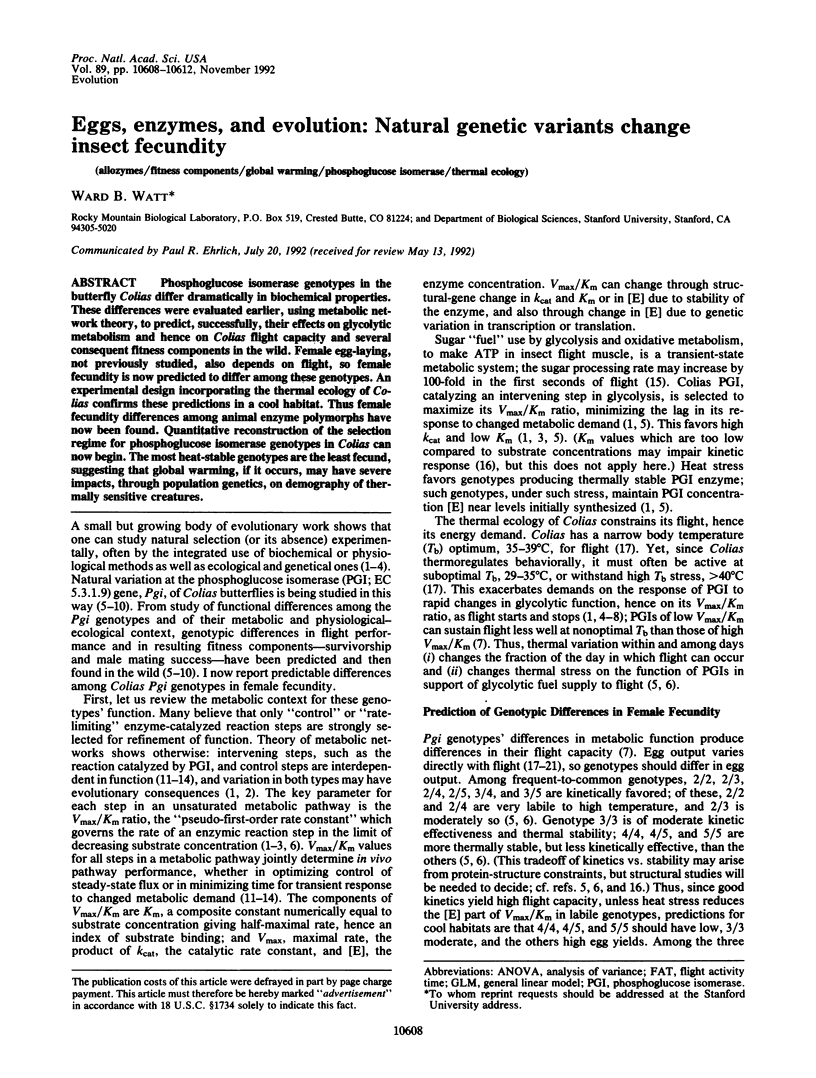
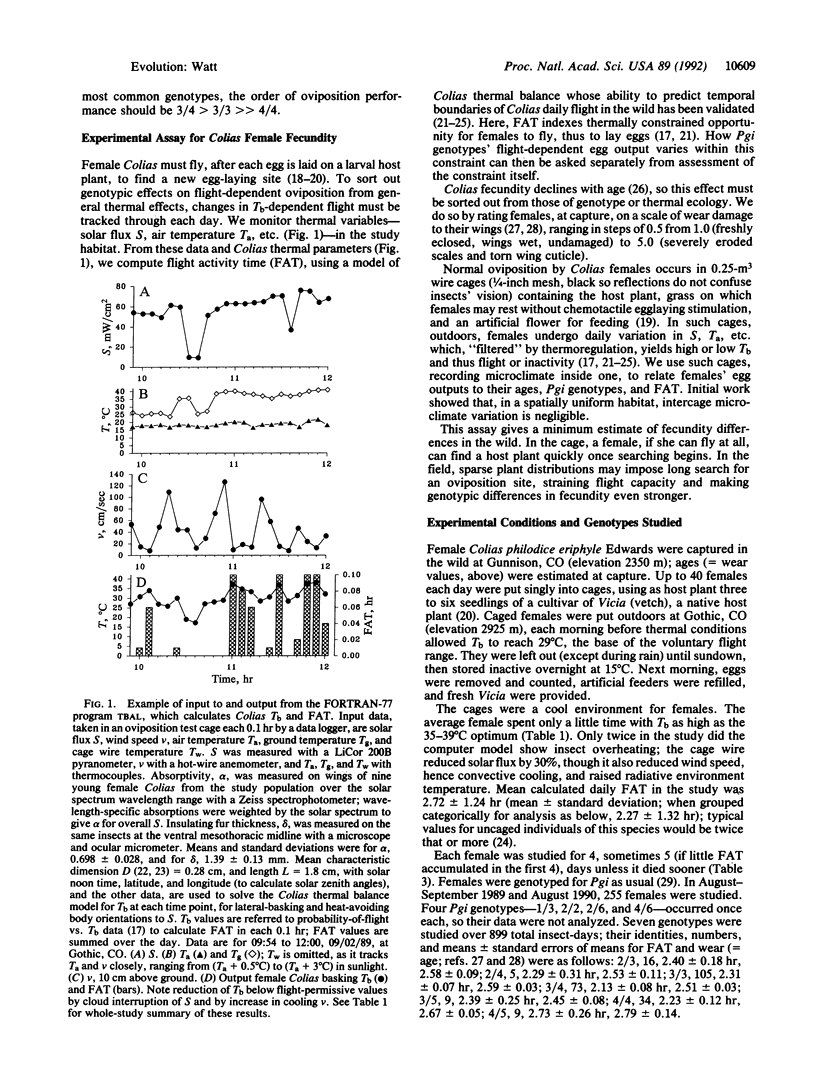
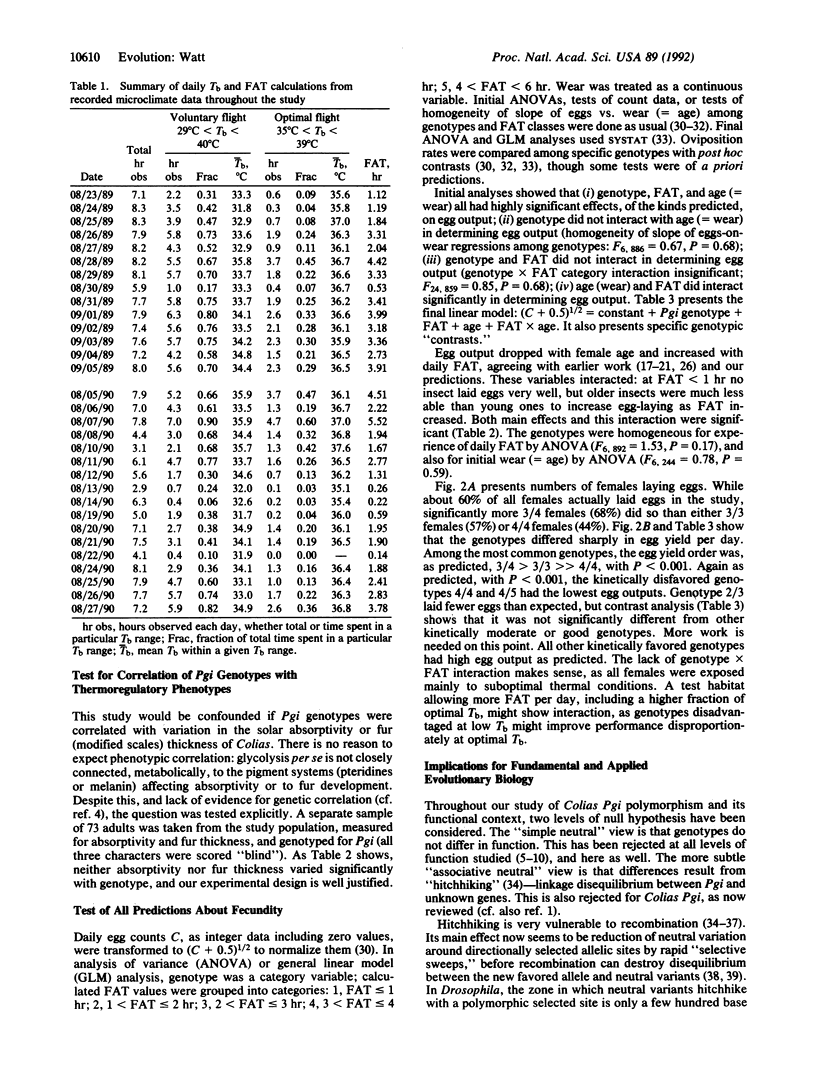
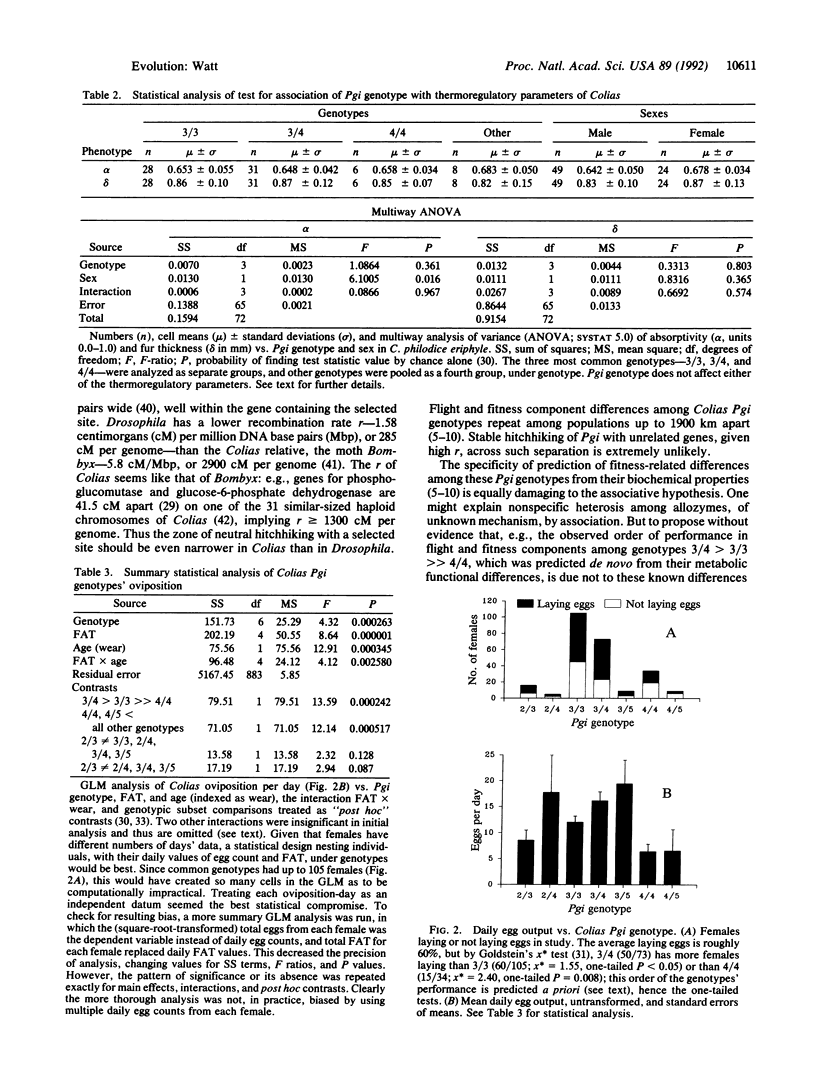
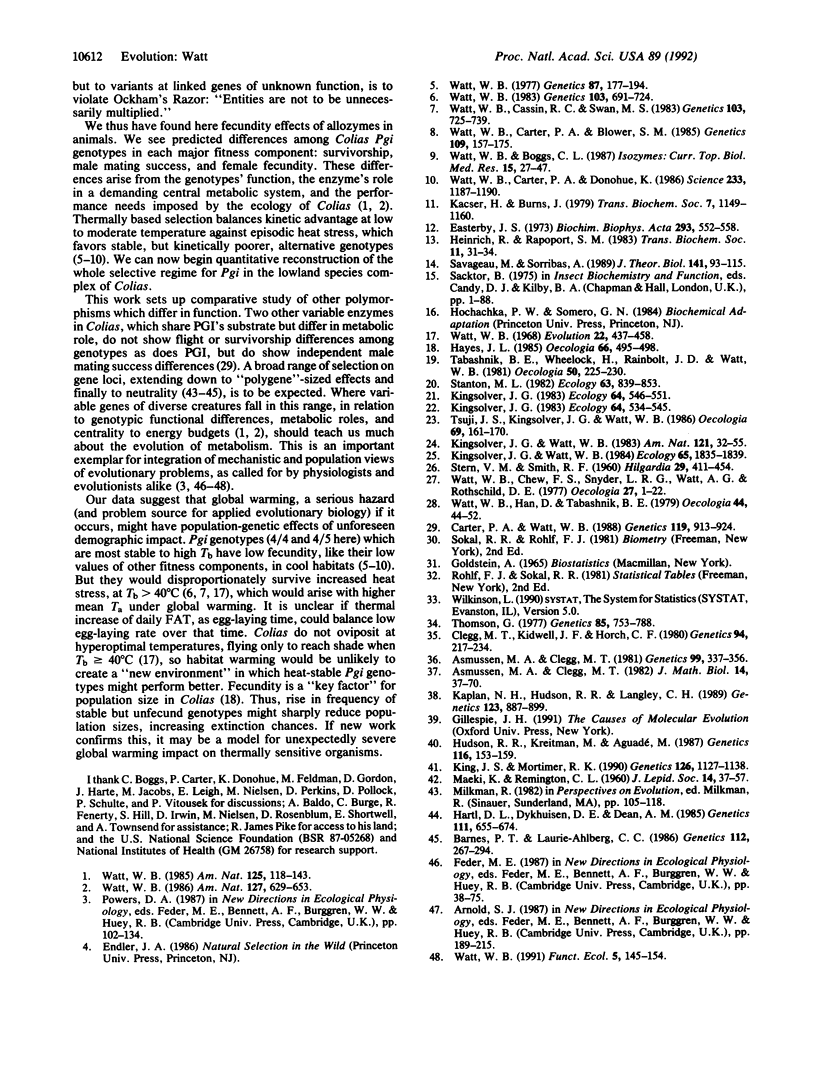
Selected References
These references are in PubMed. This may not be the complete list of references from this article.
- Asmussen M. A., Clegg M. T. Dynamics of the Linkage Disequilibrium Function under Models of Gene-Frequency Hitchhiking. Genetics. 1981 Oct;99(2):337–356. doi: 10.1093/genetics/99.2.337. [DOI] [PMC free article] [PubMed] [Google Scholar]
- Barnes P. T., Laurie-Ahlberg C. C. Genetic variability of flight metabolism in Drosophila melanogaster. III. Effects of Gpdh allozymes and environmental temperature on power output. Genetics. 1986 Feb;112(2):267–294. doi: 10.1093/genetics/112.2.267. [DOI] [PMC free article] [PubMed] [Google Scholar]
- Carter P. A., Watt W. B. Adaptation at specific loci. V. Metabolically adjacent enzyme loci may have very distinct experiences of selective pressures. Genetics. 1988 Aug;119(4):913–924. doi: 10.1093/genetics/119.4.913. [DOI] [PMC free article] [PubMed] [Google Scholar]
- Clegg M. T., Kidwell J. F., Horch C. R. Dynamics of Correlated Genetic Systems. V. Rates of Decay of Linkage Disequilibria in Experimental Populations of DROSOPHILA MELANOGASTER. Genetics. 1980 Jan;94(1):217–234. doi: 10.1093/genetics/94.1.217. [DOI] [PMC free article] [PubMed] [Google Scholar]
- Easterby J. S. Coupled enzyme assays: a general expression for the transient. Biochim Biophys Acta. 1973 Feb 15;293(2):552–558. doi: 10.1016/0005-2744(73)90362-8. [DOI] [PubMed] [Google Scholar]
- Hartl D. L., Dykhuizen D. E., Dean A. M. Limits of adaptation: the evolution of selective neutrality. Genetics. 1985 Nov;111(3):655–674. doi: 10.1093/genetics/111.3.655. [DOI] [PMC free article] [PubMed] [Google Scholar]
- Heinrich R., Rapoport S. M. The utility of mathematical models for the understanding of metabolic systems. Biochem Soc Trans. 1983 Jan;11(1):31–35. doi: 10.1042/bst0110031. [DOI] [PubMed] [Google Scholar]
- Hudson R. R., Kreitman M., Aguadé M. A test of neutral molecular evolution based on nucleotide data. Genetics. 1987 May;116(1):153–159. doi: 10.1093/genetics/116.1.153. [DOI] [PMC free article] [PubMed] [Google Scholar]
- Kacser H., Burns J. A. MOlecular democracy: who shares the controls? Biochem Soc Trans. 1979 Oct;7(5):1149–1160. doi: 10.1042/bst0071149. [DOI] [PubMed] [Google Scholar]
- Kaplan N. L., Hudson R. R., Langley C. H. The "hitchhiking effect" revisited. Genetics. 1989 Dec;123(4):887–899. doi: 10.1093/genetics/123.4.887. [DOI] [PMC free article] [PubMed] [Google Scholar]
- King J. S., Mortimer R. K. A polymerization model of chiasma interference and corresponding computer simulation. Genetics. 1990 Dec;126(4):1127–1138. doi: 10.1093/genetics/126.4.1127. [DOI] [PMC free article] [PubMed] [Google Scholar]
- Savageau M. A., Sorribas A. Constraints among molecular and systemic properties: implications for physiological genetics. J Theor Biol. 1989 Nov 8;141(1):93–115. doi: 10.1016/s0022-5193(89)80011-6. [DOI] [PubMed] [Google Scholar]
- Thomson G. The effect of a selected locus on linked neutral loci. Genetics. 1977 Apr;85(4):753–788. doi: 10.1093/genetics/85.4.753. [DOI] [PMC free article] [PubMed] [Google Scholar]
- Watt W. B. Adaptation at Specific Loci. II. Demographic and Biochemical Elements in the Maintenance of the Colias Pgi Polymorphism. Genetics. 1983 Apr;103(4):691–724. doi: 10.1093/genetics/103.4.691. [DOI] [PMC free article] [PubMed] [Google Scholar]
- Watt W. B. Adaptation at specific loci. I. Natural selection on phosphoglucose isomerase of Colias butterflies: Biochemical and population aspects. Genetics. 1977 Sep;87(1):177–194. doi: 10.1093/genetics/87.1.177. [DOI] [PMC free article] [PubMed] [Google Scholar]
- Watt W. B., Boggs C. L. Allelic isozymes as probes of the evolution of metabolic organization. Isozymes Curr Top Biol Med Res. 1987;15:27–47. [PubMed] [Google Scholar]
- Watt W. B., Carter P. A., Blower S. M. Adaptation at specific loci. IV. Differential mating success among glycolytic allozyme genotypes of Colias butterflies. Genetics. 1985 Jan;109(1):157–175. doi: 10.1093/genetics/109.1.157. [DOI] [PMC free article] [PubMed] [Google Scholar]
- Watt W. B., Carter P. A., Donohue K. Females' choice of "good genotypes" as mates is promoted by an insect mating system. Science. 1986 Sep 12;233(4769):1187–1190. doi: 10.1126/science.3738528. [DOI] [PubMed] [Google Scholar]
- Watt W. B., Cassin R. C., Swan M. S. Adaptation at Specific Loci. III. Field Behavior and Survivorship Differences among Colias Pgi Genotypes Are Predictable from IN VITRO Biochemistry. Genetics. 1983 Apr;103(4):725–739. doi: 10.1093/genetics/103.4.725. [DOI] [PMC free article] [PubMed] [Google Scholar]


